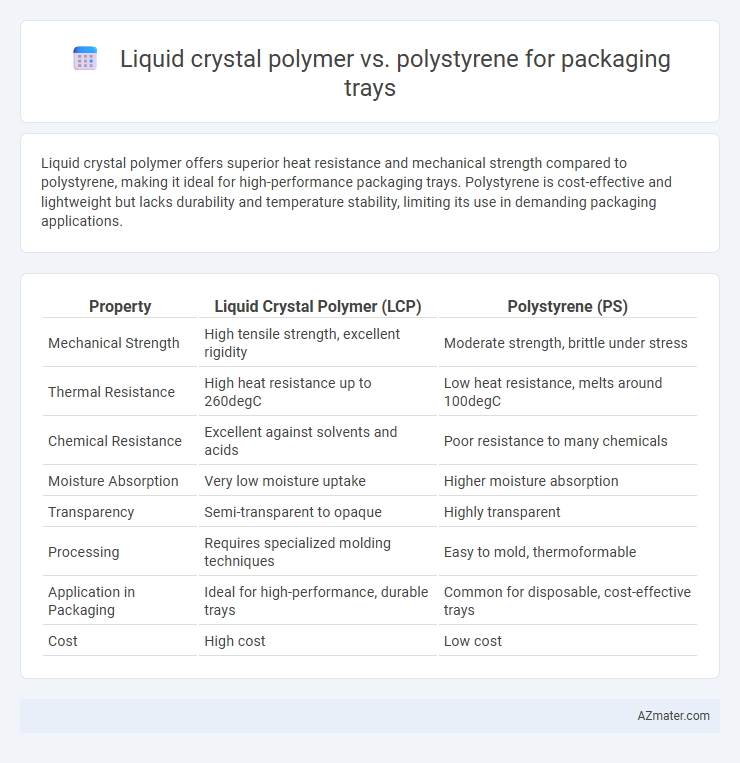Liquid crystal polymer offers superior heat resistance and mechanical strength compared to polystyrene, making it ideal for high-performance packaging trays. Polystyrene is cost-effective and lightweight but lacks durability and temperature stability, limiting its use in demanding packaging applications.
Table of Comparison
| Property | Liquid Crystal Polymer (LCP) | Polystyrene (PS) |
|---|---|---|
| Mechanical Strength | High tensile strength, excellent rigidity | Moderate strength, brittle under stress |
| Thermal Resistance | High heat resistance up to 260degC | Low heat resistance, melts around 100degC |
| Chemical Resistance | Excellent against solvents and acids | Poor resistance to many chemicals |
| Moisture Absorption | Very low moisture uptake | Higher moisture absorption |
| Transparency | Semi-transparent to opaque | Highly transparent |
| Processing | Requires specialized molding techniques | Easy to mold, thermoformable |
| Application in Packaging | Ideal for high-performance, durable trays | Common for disposable, cost-effective trays |
| Cost | High cost | Low cost |
Introduction to Liquid Crystal Polymer and Polystyrene
Liquid Crystal Polymer (LCP) is a high-performance thermoplastic known for its exceptional strength, chemical resistance, and dimensional stability, making it ideal for precision packaging trays requiring durability and thermal resistance. Polystyrene (PS), a versatile and cost-effective thermoplastic, offers ease of processing and clear transparency but has lower mechanical strength and thermal resistance compared to LCP. The choice between LCP and Polystyrene for packaging trays depends on the application's requirements for mechanical toughness, heat resistance, and cost efficiency.
Material Composition and Structure
Liquid crystal polymer (LCP) exhibits a highly ordered molecular structure with rigid rod-like polymer chains that provide exceptional mechanical strength and thermal stability, making it ideal for high-performance packaging trays. Polystyrene (PS), composed of aromatic hydrocarbon monomers arranged in an amorphous, glassy structure, offers good clarity and ease of processing but lacks the mechanical robustness and heat resistance of LCP. The semicrystalline nature of LCP results in higher dimensional stability and chemical resistance compared to the predominantly amorphous structure of polystyrene, which is more prone to brittleness and deformation under stress.
Mechanical Strength and Durability
Liquid crystal polymers (LCPs) exhibit superior mechanical strength and durability compared to polystyrene, making them ideal for high-performance packaging trays. LCPs offer exceptional tensile strength, impact resistance, and dimensional stability under stress, while polystyrene tends to be brittle and prone to cracking under heavy loads. The robust molecular alignment in LCPs enhances their resistance to deformation and chemical exposure, extending the lifespan of packaging trays in demanding environments.
Thermal Stability and Heat Resistance
Liquid crystal polymer (LCP) exhibits superior thermal stability and heat resistance compared to polystyrene, maintaining structural integrity at temperatures above 300degC, while polystyrene typically deforms around 90-100degC. The high melting point and low thermal expansion of LCP make it ideal for packaging trays exposed to elevated temperatures during sterilization or microwave use. In contrast, polystyrene's lower heat resistance limits its application to low-temperature packaging, where thermal degradation and warping are critical concerns.
Chemical Resistance and Barrier Properties
Liquid crystal polymer (LCP) exhibits superior chemical resistance compared to polystyrene, effectively withstanding exposure to solvents, acids, and bases without degradation, making it ideal for aggressive chemical packaging environments. LCP also demonstrates enhanced barrier properties against moisture, oxygen, and gases, significantly outperforming polystyrene in preserving product integrity and shelf life. In contrast, polystyrene offers lower chemical resistance and inferior barrier performance, limiting its use in applications where stringent protection against environmental factors is required.
Weight and Flexibility Comparison
Liquid crystal polymer (LCP) offers superior flexibility compared to polystyrene while maintaining a significantly lower weight, making it ideal for lightweight, durable packaging trays. Polystyrene, although rigid and cost-effective, tends to be heavier and less flexible, leading to potential cracking under stress. The high tensile strength and low density of LCP enhance packaging performance by improving impact resistance and reducing material bulk.
Cost Efficiency and Economic Considerations
Liquid crystal polymer (LCP) offers superior mechanical strength and chemical resistance compared to polystyrene, but its higher material and processing costs can impact overall packaging tray expenses. Polystyrene remains cost-effective due to lower raw material prices and established manufacturing processes, making it favorable for high-volume, low-cost packaging applications. Evaluating the trade-off between LCP's durability benefits and polystyrene's affordability is crucial for optimizing cost efficiency in packaging tray production.
Environmental Impact and Sustainability
Liquid crystal polymer (LCP) offers superior environmental benefits over polystyrene (PS) for packaging trays due to its enhanced recyclability and lower carbon footprint during production. LCP exhibits higher thermal stability and durability, reducing material waste and extending product lifecycle, which aligns with sustainability goals. Polystyrene, although widely used, generates significant non-biodegradable waste and poses challenges in recycling processes, thereby increasing environmental pollution and resource depletion.
Suitability for Packaging Applications
Liquid crystal polymer (LCP) offers superior dimensional stability, chemical resistance, and high-temperature performance, making it ideal for packaging trays subjected to harsh environments or requiring sterilization. Polystyrene (PS) is widely used for packaging due to its cost-effectiveness and ease of molding but lacks the thermal stability and mechanical strength of LCP. For applications demanding durability, precision, and resistance to deformation, LCP is more suitable, whereas PS suits disposable or low-stress packaging needs.
Choosing the Right Material: LCP vs Polystyrene
Liquid crystal polymer (LCP) offers superior mechanical strength, thermal stability, and chemical resistance compared to polystyrene, making it ideal for packaging trays requiring durability and heat resistance. Polystyrene is cost-effective and provides excellent clarity and lightweight properties but lacks the robustness needed for high-stress or high-temperature applications. Selecting LCP ensures enhanced performance in demanding environments, while polystyrene suits applications prioritizing affordability and aesthetic transparency.

Infographic: Liquid crystal polymer vs Polystyrene for Packaging tray
 azmater.com
azmater.com